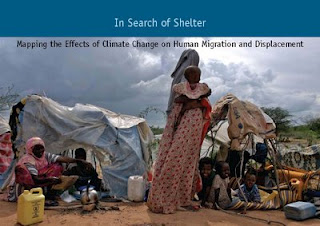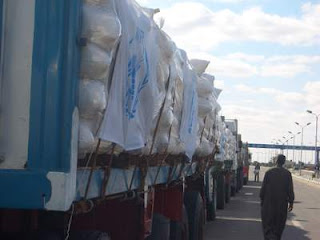-
Climate and Migration: Threat or Opportunity?
›June 26, 2009 // By Lauren Herzer Risi“The breakdown of ecosystem-dependent livelihoods is likely to remain the premier driver of long-term migration during the next two to three decades,” says In Search of Shelter: Mapping the Effects of Climate Change on Human Migration and Displacement, a report launched at the recent international climate negotiations in Bonn.
According to the report, climate change will threaten livelihoods (and could consequently drive migration) through its impact on agriculture, glacial melt, sea-level rise, and the severity and frequency of natural disasters. While the report recognizes that migration is a complex issue involving a “combination of environmental, economic, social and/or political factors,” it stresses the impact of environmental change on “livelihoods which are dependent on ecosystem services, such as agriculture, herding, and fishing.”
Key to the report’s findings is the disproportionate effect that climate change will continue to have on developing countries, which are ill-equipped to adapt to climate change, and where many people’s livelihoods depend directly on ecosystem services. The report calls for the reduction of carbon emissions to mitigate climate change; the promotion of technologies that will enable adaptation; and the active participation of women and other marginalized groups in adaptation planning.
In a recent invitation-only meeting hosted by the Wilson Center’s Environmental Change and Security Program, Jon Barnett of the University of Melbourne suggested that migration that is partially due to climate might be an opportunity, as “you could use migration to facilitate adaptation.” In Search of Shelter also recognizes this potential opportunity, and suggests that development strategies be formulated accordingly. Better infrastructure, health care, and education in likely receiving cities—many of which are in the developing world and are already overwhelmed by burgeoning slum populations—would significantly reduce the pressure of migration on both migrants and receiving populations.
In Search of Shelter is a unique contribution to the field, examining climate change’s impact on migration in a careful, evidence-based manner. Yet it strikes a common chord with general reports on development by stressing the important role that access to health care, education, and infrastructure play in supporting healthy, secure populations. It may be up for debate how large of a role climate change will play in prompting migration, but it is clear that we need to integrate this issue into broader development, health, and governance strategies.
Image: Cover of In search of shelter: mapping the effects of climate change on human migration and displacement. © 2008 by CARE International. Used by permission. -
In the Wake of Conflict, Gaza Faces Severe Public Health Challenges
›February 4, 2009 // By Lauren Herzer Risi
An 18-month blockade, three weeks of intense bombardment, and continuing sporadic violence are setting up the Gaza Strip for a “devastating humanitarian crisis,” according to the UN Office for the Coordination of Humanitarian Affairs. As of January 31, 1,380 Palestinians had been killed and 5,380 had been injured in the conflict, including many civilians. Additionally, the World Health Organization recently warned that…
Enduring [health] risks include complications and excess mortality in patients with chronic diseases as a result of the suspension of treatment and delayed access to health care during the conflict; diarrhea outbreaks from water-borne and food-borne diseases as a result of the lack of access to clean water and sanitation and the weak public health surveillance system; as well as long-term mental health problems as a result of the conflict.
Slightly more than twice the size of Washington, D.C., with a population of 1.5 million people, the Gaza Strip is among the most densely populated regions in the world. Gaza’s high population density has likely compounded residents’ vulnerability to white phosphorus, a highly flammable chemical that provides smoke screens for troop movements. The outrage provoked by its use by the Israeli Defense Forces (IDF) stems from the intense, uncontrollable fires it causes. The IDF has admitted to using white phosphorus in Gaza against Hamas and is investigating whether it also used it against residents, which is prohibited by the 1980 Convention on Conventional Military Weapons.
In 2008, prior to the war, the UN Relief and Works Agency reported that despite the humanitarian assistance flowing to Gaza, 51.8 percent of households were below the poverty line, and unemployment was at an unprecedented high of 45.3 percent. Prior to the recent conflict, 80 percent of the population was dependent on aid from the United Nations.
Although the current ceasefire has allowed for a slight increase in access to Gaza, humanitarian agencies and aid workers still struggle to get supplies into the territory. Day after day, truckloads of supplies—everything from food, clothing, and baby formula to blankets, plastic tarps, and technical equipment to draw water from the ground—sit at border crossings in Egypt, waiting for permission to enter Gaza. While Egyptians blame the Israelis for limiting access, Israeli officials claim that the Egyptians have not done enough to coordinate the flood of aid. Regardless of who is to blame, it is clear that limiting the access of humanitarian workers and supplies is having dire consequences for the residents of Gaza.
Photo: Humanitarian cargo waits at the Rafah border crossing on the Gaza-Egyptian border on January 9, 2009. Photo courtesy of Ekram Elhuni (World Food Programme) and Flickr user Peter Casier. -
Lethal Rockslide in Cairo Slum Reveals Government’s Lack of Preparedness
›September 30, 2008 // By Lauren Herzer RisiEarlier this month, approximately eight boulders weighing 60-70 tons each split from the edges of the Muqattam cliffs and fell onto densely populated Manshiyet Nasr, a slum in eastern Cairo, killing more than 100 people and destroying 30-50 homes. By the next day, security officials outnumbered rescue workers in the area, and locals, outraged by the slow response of the government, were clashing with police. This tragedy and the ensuing conflict between residents and local authorities highlight the need for effective governance and urban planning to alleviate poverty and rapid urbanization and avoid conflict.
Rockslides are not uncommon in Manshiyet Nasr; in 2002, for example, 27 people were killed under similar circumstances in the same area. One local journalist reported that “the reason the rocks keep falling is because there is no sewage system and their wastewater is eating away at the mountain.” This lack of basic sanitation services is a common characteristic of the informal settlements and slums that are growing exponentially worldwide. This year, for the first time, more than half of the global population lives in cities; it is forecast that by 2030, 81 percent of the urban population will reside in the cities of developing countries, which are unplanned, underserved by services like sanitation, and unable to cope with continually growing demand for these services. The rockslide in Manshiyet Nasr is a stark example of what can happen when a city’s infrastructure and government are unprepared to deal with rapid urbanization and increasing poverty, and how these challenges are exacerbated by poor government response. (For more on Cairo’s informal settlements, see the Comparative Urban Studies Project’s Urban Studies in Cairo, Egypt.)
A recent Human Development Report analyzing Egypt’s progress toward attaining the Millennium Development Goals noted that the poverty rate in Cairo, a city of 16 million people, is expected to almost double between now and 2015. This growth in poverty is attributed to “increasing numbers of residents in vulnerable areas and increasing rates of internal migration.”
It is important to note, however, that migration alone does not account for increasing poverty. In Global Urban Poverty, a publication of the Wilson Center’s Comparative Urban Studies Project and the U.S. Agency for International Development, Loren Landau argues that “public responses to migration and urbanization—including the absence of a conscious coordinated response—have tended to exacerbate mobility’s negative effects on all of the Millennium Development Goals.”
The Egyptian government’s initial response to the rockslide in Manshiyet Nasr was to hold the residents accountable for living in an illegal settlement in a dangerous area. Yet 70 percent of Cairo residents live in informal communities like Manshiyet Nasr. In addition to a severe housing shortage and lack of urban planning, a history of slow government response to disasters is intensifying accusations of government neglect and incompetence.
Except for an 18-month break in 1980-81, Egyptians have lived under emergency law since 1967. This law prohibits public gatherings, restricts speech, permits searches without warrants, and enables the police to detain citizens without charge or trial. After promising to repeal the law during his 2005 presidential campaign, Hosni Mubarek, who has been in power since 1981, extended the law in 2006 and again in May of this year. While proponents of the law (and of Mubarek) claim that the state of emergency has helped stabilized the country, human rights groups argue that the law violates human rights and sanctions the government’s oppression of political rivals.
Egypt’s history of extreme law and unchecked police powers has stunted the development of a system of governance that responds to the most basic needs of Egyptians. Manshiyet Nasr residents’ angry reaction to the poor government response to the rockslide is evidence of their smoldering desperation.
Showing posts by Lauren Herzer Risi.






